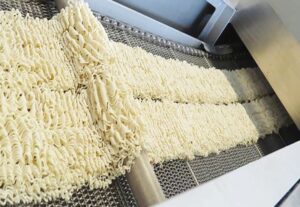 Sodium Dihydrogen Phosphate (NaH2PO4) is the secret behind the delightful taste and texture of instant noodles. Let’s explore how it works with its functional principles, reaction processes, and variable control, making instant noodles a beloved convenience food worldwide.
Sodium Dihydrogen Phosphate (NaH2PO4) is the secret behind the delightful taste and texture of instant noodles. Let’s explore how it works with its functional principles, reaction processes, and variable control, making instant noodles a beloved convenience food worldwide.
Functional Principles: The Multi-Faceted Aid
Sodium Dihydrogen Phosphate is a multifunctional food additive with a wide array of benefits. Its primary functions are as follows:
Emulsifying Stabilizer
Sodium Dihydrogen Phosphate demonstrates excellent emulsifying stability, ensuring the uniform dispersion of oil and water in the seasoning sauce. This facilitates the creation of a harmonious blend between the oil and water components, enhancing the texture and smoothness of the noodles. The emulsification process prevents oil separation and ensures a consistent mouthfeel throughout the noodle dish.
pH Regulation
Being a monobasic salt, Sodium Dihydrogen Phosphate dissolves in water, releasing hydroxide ions (OH^-) and dihydrogen phosphate ions (H2PO4^-). This property allows NaH2PO4 to serve as a pH regulator in instant noodles. By adjusting the pH value, it ensures the appropriate acid-base environment during noodle processing, which plays a pivotal role in the noodle dough’s fermentation and quality control.
Dough Conditioning
During the noodle dough preparation, Sodium Dihydrogen Phosphate acts as a dough conditioner. It enhances the gluten network formation, leading to improved dough elasticity and extensibility. This allows the dough to stretch more easily during processing, resulting in smoother and more uniform noodles.
Water Absorption
Sodium Dihydrogen Phosphate exhibits water-absorbing properties. It can absorb and retain water within the noodle dough and the seasoning sauce. This water absorption capability helps prevent the noodles from becoming too dry during cooking, ensuring that they remain moist and tender.
Texture Modification
The presence of Sodium Dihydrogen Phosphate affects the texture of the instant noodles. It can influence the degree of swelling and gelatinization of the starch in the noodle dough, resulting in noodles with different textures, such as firmer or more elastic noodles.
Buffering Action
As a buffering agent, Sodium Dihydrogen Phosphate helps maintain the pH stability of the seasoning sauce. It resists changes in pH caused by other ingredients or external factors, ensuring that the flavor and quality of the seasoning remain consistent.
Shelf-Life Extension
Sodium Dihydrogen Phosphate contributes to the extended shelf life of instant noodles by inhibiting the growth of microorganisms. Its pH-regulating property helps create an unfavorable environment for microbial growth, reducing the risk of spoilage and enhancing the product’s shelf stability.
Reaction Processes: Unraveling the Magic
The reaction processes involving Sodium Dihydrogen Phosphate in instant noodles are crucial to their successful production.
Emulsifying Stabilization
When Sodium Dihydrogen Phosphate is added to the seasoning sauce, it reacts with the fatty acids present in the oil component of the sauce:
R-COOH (Fatty Acid) + OH^- ⇌ R-COO^- (Fatty Acid Ion) + H2O
In this reaction, the fatty acid ion (R-COO^-) formed combines with the dihydrogen phosphate ion (H2PO4^-) of NaH2PO4, creating a complex compound:
R-COO^- + H2PO4^- ⇌ R-COOP2O4^- (Complex Compound)
The formation of this compound results in a polar head and a nonpolar tail structure in the seasoning sauce, promoting the stable dispersion of the oil phase within the water phase.
pH Regulation
Sodium Dihydrogen Phosphate dissociates in water to release hydroxide ions and dihydrogen phosphate ions:
NaH2PO4 + H2O ⇌ Na+ + H2PO4^- + OH^-
This equilibrium reaction allows NaH2PO4 to control the pH value, ensuring an appropriate level for the noodle dough’s fermentation and the seasoning sauce’s stability.
Variable Control: Mastering the Art of Quality
In the production of instant noodles, precise control of variables related to Sodium Dihydrogen Phosphate is vital for achieving consistent and desirable results.
Amount Control
The recommended amount of Sodium Dihydrogen Phosphate (NaH2PO4) generally ranges from 0.1% to 0.3% (based on the overall percentage of the seasoning sauce). The specific amount depends on the desired emulsification stability and pH regulation. Careful consideration is required to avoid overemulsification or excessive pH adjustment, which could adversely affect the noodle quality.
pH Value Control
Maintaining the ideal pH value in the noodle dough and the seasoning sauce is essential for ensuring proper fermentation and taste. Controlling the amount of Sodium Dihydrogen Phosphate helps achieve the desired pH level and maintains a balance between acidity and alkalinity.
Temperature Control
The processing temperature plays a vital role in the emulsification and pH regulation processes. Proper control of temperature during the mixing and cooking stages ensures the effective functionality of Sodium Dihydrogen Phosphate and maintains the overall quality of instant noodles.
Sodium Dihydrogen Phosphate provides a unique set of functional principles, reaction processes, and variable control that elevate the beloved convenience food to new heights. As a masterful emulsifying stabilizer and a pH regulator, Sodium Dihydrogen Phosphate empowers instant noodles with exceptional taste, texture, and quality.
And if you’re looking for Sodium Dihydrogen phosphate for instant noodles, contact us at [email protected] anytime, your satisfaction is our incessant goal.




